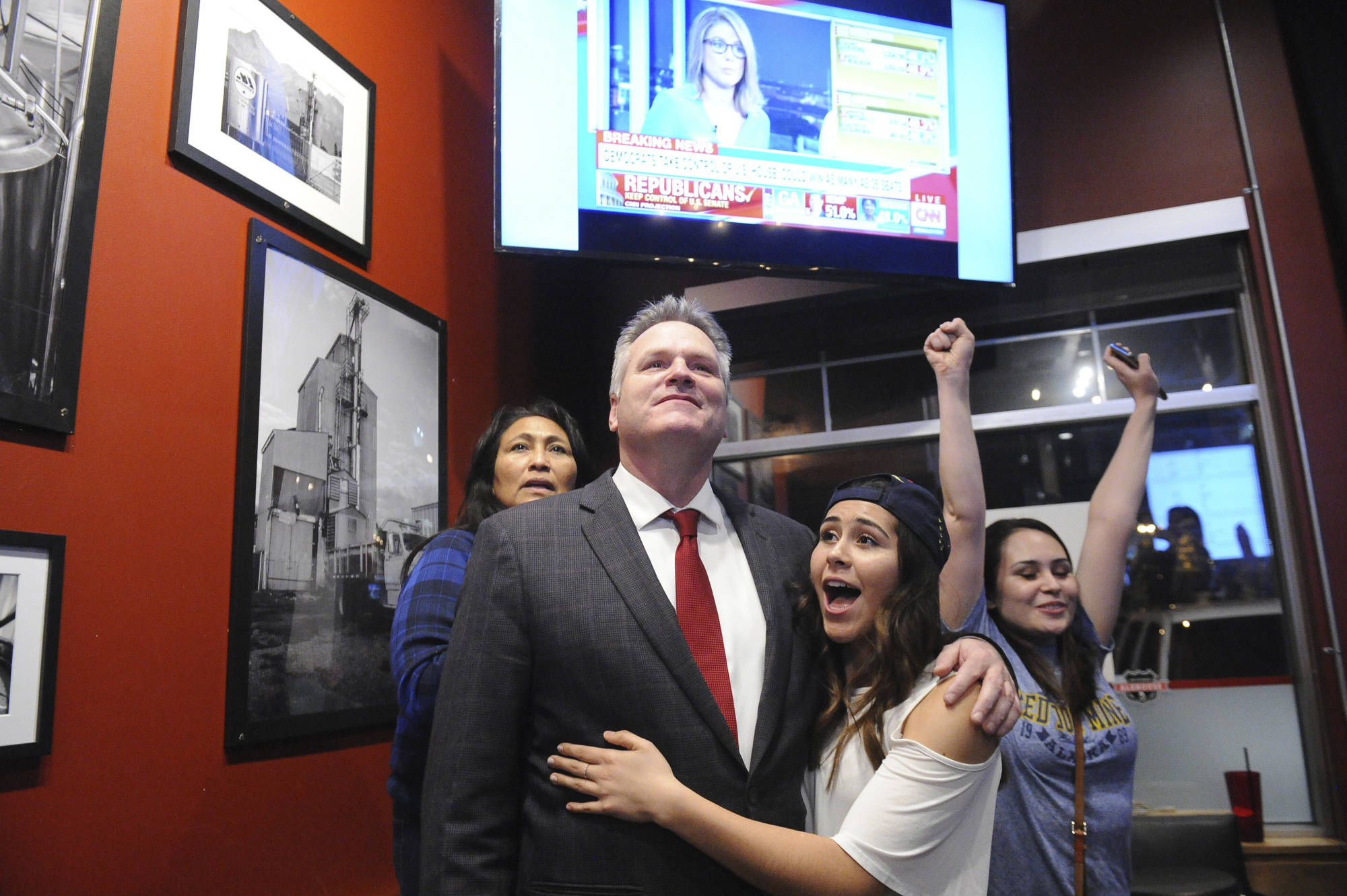Mike Dunleavy will be Alaska’s next governor.
Dunleavy, the Republican candidate, led Democratic candidate Mark Begich by 8.8 percentage points with 432 of 441 precincts reporting results at 2 a.m., defying predictions of a close race.
While Democrats across the Lower 48 may have experienced a “Blue Wave” as politicians from that party swept into office, it was the opposite in Alaska as Republicans surged across the state.
Prospects across Alaska were good for Republicans on election night, with Rep. Don Young winning a 24th term in office. Young led independent challenger Alyse Galvin with 53.94 percent of the vote to Galvin’s 45.64 percent with 433 precincts reporting.
The early results of statehouse races indicate control of each body remains in the balance. Republican Senate President Pete Kelly appears to be in a tight race with Democrat Scott Kawasaki for Senate District A, and the Democratic-led coalition in charge of the House lost key members, including Homer Rep. Paul Seaton and Anchorage independent Rep. Jason Grenn. Several races may be decided by absentee and questioned ballots.
In Juneau, there was no doubt.
Democratic candidate Jesse Kiehl led Don Etheridge by 23.59 percentage points to replace Sen. Dennis Egan, D-Juneau, in the Alaska Senate. Seventeen of 18 precincts were reporting in Senate District Q. The only remaining precinct to report was Haines No. 2, which was expected to return results Wednesday.
“That’s really humbling is what it is. That exceeds my expectations for how it’s going to go tonight,” Kiehl told the Empire.
After a day of campaigning, Etheridge met supporters for a gathering at the Frontier Suites Orca Room.
“We just fought a hard fight and it wasn’t in the cards. You give it a try and it’s not what the people wanted,” he said after 14 precincts had reported their results.
In Douglas, downtown Juneau and the communities of northern Lynn Canal, Democratic candidate Sara Hannan led independent Chris Dimond by 12 points to represent House District 33 and replace incumbent Rep. Sam Kito III, D-Juneau. Ten of 11 precincts were reporting; again, Haines No. 2 precinct did not report results on election night.
Hannan, interviewed at the Empire’s election central event, said she believes she won because the district sought someone definitively progressive.
“I think that I share the true progressive values of this district,” she said.
Speaking before final results, Dimond said he was pleased with his campaign, regardless of the outcome.
“Win or lose, I’ll feel good in the morning,” Dimond said.
In the Mendenhall Valley, Democratic candidate Andi Story defeated Republican Jerry Nankervis by six points to replace incumbent Rep. Justin Parish, D-Juneau in House District 34. All seven precincts were reporting.
Nankervis, reached by phone, thanked his volunteers and backers for a “humbling and rewarding” experience.
“I enjoyed it. Again, it’s been an honor to serve on the Assembly, and an honor to do this,” he said. “It was fun to do this race. It just didn’t turn out the way I wanted.”
Nankervis said he will leave Friday for his annual deer hunting trip.
Ballot Measure 1, which proposed tougher environmental protections for salmon habitat, failed by a 2:1 margin, trailing 36.38 percent to 63.62 percent with 432 of 441 precincts reporting.
The debate over Ballot Measure 1 became the most expensive state-level campaign in Alaska history as petroleum, construction and mining companies spent millions to defeat the proposition.
The governor’s race, however, seemed to garner the majority of public attention as it came to a tumultuous end.
Dunleavy led opinion polls throughout the summer, and he kept that lead even as the abrupt resignation of Lt. Gov. Byron Mallott upended the race. Mallott’s resignation from office following “inappropriate comments” to an unidentified woman triggered incumbent Gov. Bill Walker to suspend his race for re-election days later.
Walker urged his supporters to support Begich, and though he remained on the Election Day ballot, his message appears to have resonated with voters. Walker received only 1.99 percent of the vote. Libertarian candidate Billy Toien received 1.84 percent of the vote, with 432 precincts reporting.
Voter turnout appeared to be running behind the midterm election four years ago, when 56.1 percent of Alaska’s registered voters cast ballots. That election, like this one, saw the governor on the ballot, but it also had a U.S. Senate contest and ballot measures that raised the minimum wage and legalized recreational marijuana.
This year, 63,228 Alaskans voted before Election Day, setting a record with 37,626 early votes cast at polling stations, but absentee voting was less common than it was four years ago, and initial returns indicated similar trends for Election Day voting: High for a midterm, but less than 2014.
Juneau and northern Lynn Canal could be an exception to that statewide trend: 22.8 percent of voters in the Mendenhall Valley’s House District 34 cast ballots before Election Day, as did 21 percent of voters in House District 33, which includes Douglas, downtown Juneau and the communities at the northern end of Lynn Canal.
• Contact reporter James Brooks at jbrooks@juneauempire.com or 523-2258.

